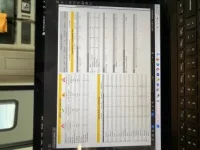madhatter1
Legendary Member
- Joined
- Jul 12, 2010
- Messages
- 1,778
- Status
- OWNER - I own a Hatteras Yacht
- Hatteras Model
- 34' CONVERTIBLE (1965 - 1969)
How accurate are these? I'm not so sure. Both my engines got flagged for x, y, and z earlier this year. Changed oil to mechanics recommended Chevron Delo 100 (had been using the NAPA oil) and took samples 35 hours or so later. Most of that time ran at 1800-1900. Suddenly they are "healed and healthy". No flags. Below are the old/new numbers.
Port
Iron 119-17
Chrome 6-1
Tin 16-1
Soot 50-30
STB
Silicone 24-20 (at 20 no longer flagged as an issue)
Tin 15-2
Iron 215-25
Chrome 34-2
Aluminum 35-2
Soot 56-26.
Tranny's show good. Generator (2003 13KW Onan with 1600 hours) shows sodium flagged at 221 and Aluminum flagged at 33. Oil (use Rotella synthetic blend) always looks great on the stick plus mid year I do a quick change without changing the filter. Generators cruise at highway miles unlike the mains running uphill everywhere they go. I really don't think there is anything to worry about. Samples are done by CAT.
Installing new gen this winter. Think I'll send a sample on that at 100 hours and see what they come up with. Thoughts?
Port
Iron 119-17
Chrome 6-1
Tin 16-1
Soot 50-30
STB
Silicone 24-20 (at 20 no longer flagged as an issue)
Tin 15-2
Iron 215-25
Chrome 34-2
Aluminum 35-2
Soot 56-26.
Tranny's show good. Generator (2003 13KW Onan with 1600 hours) shows sodium flagged at 221 and Aluminum flagged at 33. Oil (use Rotella synthetic blend) always looks great on the stick plus mid year I do a quick change without changing the filter. Generators cruise at highway miles unlike the mains running uphill everywhere they go. I really don't think there is anything to worry about. Samples are done by CAT.
Installing new gen this winter. Think I'll send a sample on that at 100 hours and see what they come up with. Thoughts?


